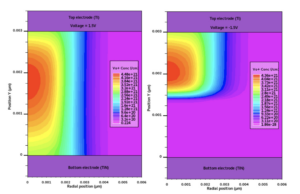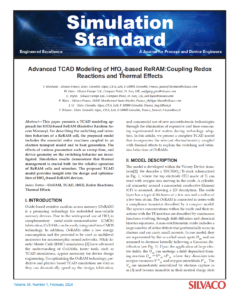Advanced TCAD Modeling of HfO2-based ReRAM: Coupling Redox Reactions and Thermal Effects
Abstract—This paper presents a TCAD modeling approach for HfO2-based ReRAM (Resistive Random Access Memory). For describing the switching and retention behaviors of a ReRAM cell, the proposed model includes the essential redox reactions coupled to an electron transport model and to heat generation. The effects of various parameters such as sweep time, and device geometry on the switching behavior are investigated. Simulation results demonstrate that thermal management is crucial both for the reliable operation of ReRAM cells and retention. The proposed TCAD model provides insight into the design and optimization of HfO2-based ReRAM devices.
Index Terms—OxRAM, TCAD, HfO2, Redox Reactions, Thermal Effects
I. INTRODUCTION
Oxide-based resistive random access memory (OxRAM) is a promising technology for embedded non-volatile memory devices. Due to the widespread use of HfO2 in complementary metal-oxide-semiconductor (CMOS) fabrication, OxRAMs can be easily integrated into CMOS technology. In addition, OxRAMs offer a low energy consumption and the potential to be used as multilevel memories for neuromorphic neural networks. While kinetic Monte Carlo (KMC) simulations [1] have advanced the understanding of OxRAMs, faster tools, such as TCAD simulations, appear necessary for device design engineering. For optimizing the OxRAM technology, predictive and physics-based TCAD simulations are vital as they can dramatically speed up the design, fabrication, and commercial use of new microelectronic technologies through the elimination of expensive and time-consuming experimental test wafers during technology adoption. In this article, we present a complete TCAD model that incorporates the relevant electrochemistry coupled with thermal effects to explain the switching and retention behaviors of OxRAMs.



